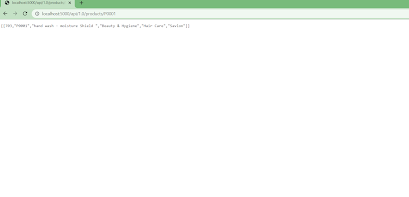NOTE -
a. Should have ideally kept the RDS database in a Private Subnet
b. Could also have kept the ECS cluster in Private Subnet (Ref URL - https://repost.aws/knowledge-center/ecs-fargate-tasks-private-subnet)
Step 1 - Create a flask application that talks to a locally installed Postgres database
Ref URL - REST API Design Principles: https://www.freecodecamp.org/news/rest-api-best-practices-rest-endpoint-design-examples/
1.1 Create a Flask application
from flask import Flask
app = Flask(__name__)
@app.route(‘/')
def hello_world():
return’ Hello World’
if __name__ == ‘__main__’:
app.run(debug=True)
Tested @ http://127.0.0.1:5000/
1.2 Connect the application to Postgres
from flask import Flask, abort, jsonify
import psycopg2
app = Flask(__name__)
myconn = psycopg2.connect(database = "DataWarehouseX", user = "postgres", password = "xxxxx", host = "localhost", port = "5432")
mycursor = myconn.cursor()
@app.route("/api/1.0/products")
def products_view():
try:
global mycursor
mycursor.execute("SELECT * FROM core.dim_product")
db=[]
for x in mycursor:
db.append(x)
return jsonify(db)
except IndexError:
abort(404)
@app.route("/api/1.0/products/<id>")
def product_view(id):
try:
global mycursor
cmd = "SELECT * FROM core.dim_product where product_id = " + "'"+id+"'"
mycursor.execute(cmd)
db=[]
for x in mycursor:
db.append(x)
return jsonify(db)
except IndexError:
abort(404)
if __name__ == '__main__':
app.run(debug=True)
API in action -
Step 2 - Dockerize the application and run containers locally
Ref URL - https://www.freecodecamp.org/news/how-to-dockerize-a-flask-app/
app.py -
#To connect to the localhost postgresDB, switched to 'host.docker.internal'
from flask import Flask, abort, jsonify
import psycopg2
app = Flask(__name__)
myconn = psycopg2.connect(database = "DataWarehouseX", user = "postgres", password = "xxxx", host = "host.docker.internal", port = "5432")
mycursor = myconn.cursor()
@app.route("/")
def hello_world():
return 'Hello from docker!'
@app.route("/api/1.0/products")
def products_view():
try:
global mycursor
mycursor.execute("SELECT * FROM core.dim_product")
db=[]
for x in mycursor:
db.append(x)
return jsonify(db)
except IndexError:
abort(404)
@app.route("/api/1.0/products/<id>")
def product_view(id):
try:
global mycursor
cmd = "SELECT * FROM core.dim_product where product_id = " + "'"+id+"'"
mycursor.execute(cmd)
db=[]
for x in mycursor:
db.append(x)
return jsonify(db)
except IndexError:
abort(404)
if __name__ == '__main__':
app.run(debug=True)
Dockerfile -
FROM python:3.8-slim-buster
WORKDIR /python-docker
COPY requirements.txt requirements.txt
RUN pip3 install -r requirements.txt
COPY . .
CMD [ "python3", "-m" , "flask", "run", "--host=0.0.0.0"]
Requirements.txt
#Had issues using the flask version I was using in Spyder. After checking the below page, decide to remove the flask version from requirements.txt
#https://stackoverflow.com/questions/71718167/importerror-cannot-import-name-escape-from-jinja2
#Had issues building docker image with psycopg2. Hence, switched to psycopg2-binary
flask
psycopg2-binary

Step 3 - Create a RDS postgres database, load data into it, switch to using it in your rest API application
Ref URL - https://sakyasumedh.medium.com/deploy-backend-application-to-aws-ecs-with-application-load-balancer-step-by-step-guide-part-1-91935ae93c51
Had to create a Public database so that can connect to it from my LVDI and load data. Plus also connect to it from my dockerized rest API application on my local machine
Data migration -
Ref URL - https://docs.aws.amazon.com/AmazonRDS/latest/UserGuide/USER_ConnectToPostgreSQLInstance.html
Exported data from local database table into a CSV file
Imported data from CSV file into RDS database table
Connection from container to WWW works out of the box
Hence, only had to make the following change to the app.py file -
myconn = psycopg2.connect(database = "DataWarehouseX", user = "postgres", password = "xxxx", host = "rest-ecs-db.c6nvu354y8s3.us-east-1.rds.amazonaws.com", port = "5432")
Also had to fix the inbound rule for the RDS database instance to allow inbound connection from anywhere on port 5432
Step 4 - Create an ECR repo and push images to that repo
Ref URL - https://sakyasumedh.medium.com/deploy-backend-application-to-aws-ecs-with-application-load-balancer-step-by-step-guide-part-2-e81d4daf0a55
Created an ECR repo
Ran AWS configure in Visual Studio terminal where the image file exists
Then followed the push commands specified on the ECR console
Step 5 - Setup ECS cluster and deploy application to ECS
Ref URL - https://sakyasumedh.medium.com/deploy-backend-application-to-aws-ecs-with-application-load-balancer-step-by-step-guide-part-3-b8125ca27177
Had to expose port 5000
Step 6 - Add a load balancer
Ref URL - https://sakyasumedh.medium.com/setup-application-load-balancer-and-point-to-ecs-deploy-to-aws-ecs-fargate-with-load-balancer-4b5f6785e8f
Had to expose port 5000 everywhere (in ALB listened, in Target Group etc.)
Step 7 - Add a custom domain name
https://docs.aws.amazon.com/Route53/latest/DeveloperGuide/routing-to-elb-load-balancer.html
Had to register domain. Will automatically create a public hosted zone.
Creating a CNAME record like
api.anandmusings.link pointing to the alb - rest-ecs-rds-alb-445658067.us-east-1.elb.amazonaws.com worked
Alias record wasn't working for some reason. Deleted a few times and created afresh. And that too started working







